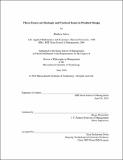Three essays on strategic and tactical issues in product design by Matthew Selove.
Author(s)
Selove, Matthew McCloud
DownloadFull printable version (1.573Mb)
Alternative title
Strategic and tactical issues in product design
Other Contributors
Sloan School of Management.
Advisor
Birger Wernerfelt.
Terms of use
Metadata
Show full item recordAbstract
This dissertation consists of three essays on strategic and tactical issues in product design. The first essay presents a dynamic investment game in which firms that are initially identical develop assets which are specialized to different market segments. The model assumes there are increasing returns to investment in a segment, for example, due to word-of-mouth or learning curve effects. In equilibrium, firms that are only slightly different focus all of their investment in different segments, causing small random differences to expand into large permanent differences. Even though firms do not cooperate and do not make threats to punish each other, in the long run they divide the market, reaching the same outcome that they would if they cooperated to maximize joint profits. This second essay develops a model in which an incumbent has expertise in an old business format (e.g., running a full service airline), and a new firm enters the market with the possibility of using a new business format (e.g., running a "no frills" airline). Firms play a dynamic investment game in which the incumbent can invest in the new format and the entrant can invest in either format. If brand and format preferences are strong, and if it is easy to implement a format, then a firm already using one format does not invest in the other format, since such an attack would be met with swift retaliation. In this case, the entrant invests in the new format, while the incumbent avoids investing in order to retain the threat of investment as a punishment mechanism. The third essay shows that improved accuracy in conjoint analysis has important strategic implications. Even if two models provide unbiased part-worths, competitive game theory shows that the more accurate model (with lower error variance in an HB CBC model) implies that differentiation from competitors is more profitable. On the other hand, a less accurate model implies that each firm should forego differentiation and choose feature levels that provide customers the greatest utility (adjusting for marginal cost). I illustrate the theory by varying accuracy in a student-apparel application.
Description
Thesis (Ph. D.)--Massachusetts Institute of Technology, Sloan School of Management, 2010. This electronic version was submitted by the student author. The certified thesis is available in the Institute Archives and Special Collections. Cataloged from student submitted PDF version of thesis. Includes bibliographical references.
Date issued
2010Department
Sloan School of ManagementPublisher
Massachusetts Institute of Technology
Keywords
Sloan School of Management.